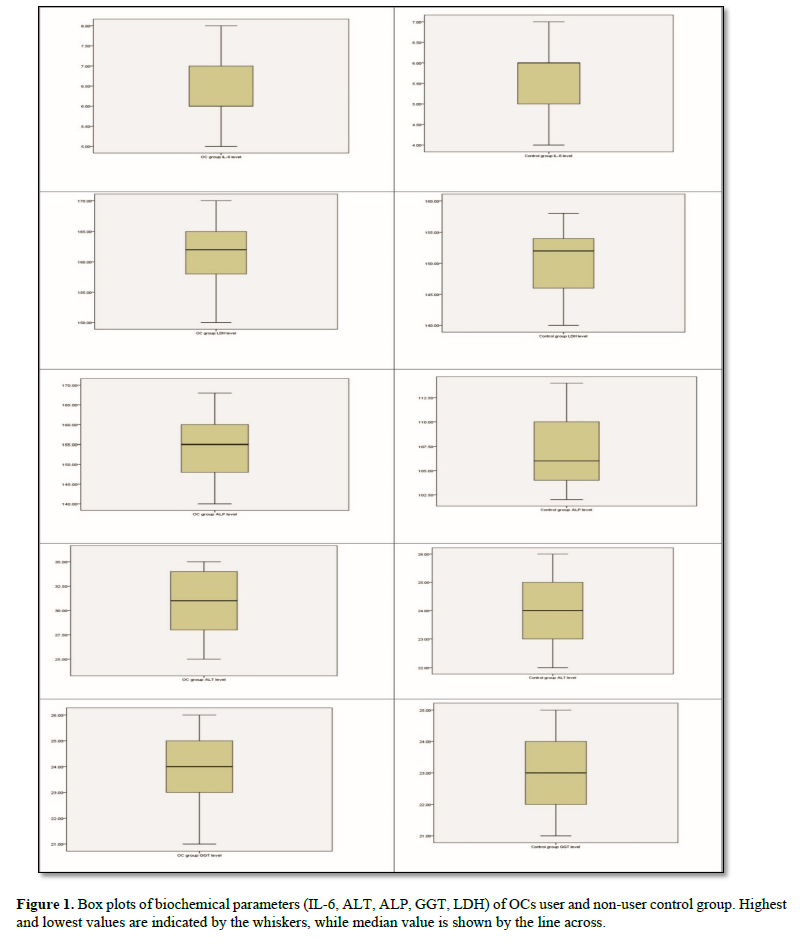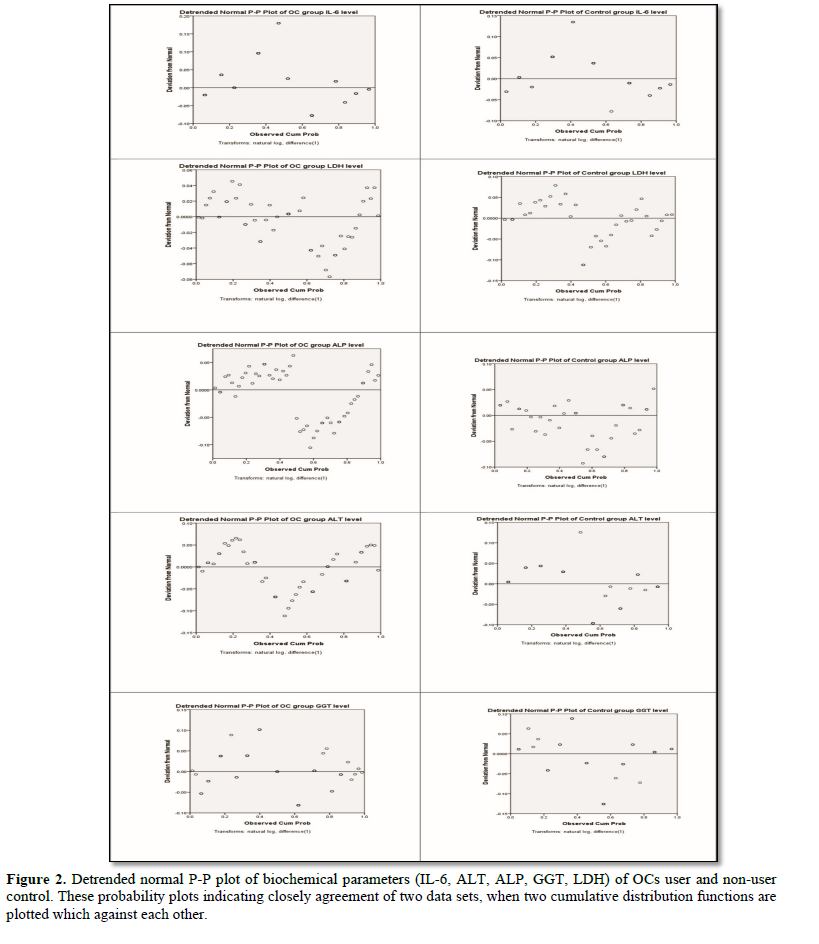Research Article
Serum Interleukin-6, C-Reactive Protein and Enzymatic Profile Variations as Potential Biomarkers of Hormonal Oral Contraceptive Induce Damages
3283
Views & Citations2283
Likes & Shares
Background: The synthetic hormonal contraceptive usage among women has raised serious health concerns. This investigative study designed to evaluate the altered manifestation of blood inflammatory biomarkers (CRP, IL-6) and serum enzymes (LDH, ALP, ALT, GGT) levels in oral hormonal contraceptive users and control group.
Materials and Methods: This descriptive study was conducted at Gomal Medical College and Mufti Mahmood Memorial Teaching Hospital, D.I. Khan, Pakistan, from September 2019 to July 2020. Following informed consent, (n=90) individuals were enrolled consisting of (n=50) oral hormonal contraceptives users and (n=40) non-contraceptives user women as control. The information about age, reproductive & medical history, nature of menstrual cycle, chronic diseases and intake of any medication were obtained on a self-developed questionnaire.
Results: SerumIL-6, ALT, ALP & LDH levels of OCs user was significantly elevated from non-user group with p
Conclusion: Inflammatory markers and enzymatic analysis showed significantly high IL-6, ALT, ALP & LDH levels in OC users that indicate acute inflammatory conditions. These findings suggest that OCs pills impair hepatic function and induces inflammatory condition in the body.
Keywords: Inflammatory markers, Oral contraceptives, Alanine aminotransferase, CRP, Lactate dehydrogenase
INTRODUCTION
Today, the excessive exogenous female hormones usages as oral contraceptives have risen concerned regarding their deleterious effects on women health. Several epidemiological studies have reported the association between use of exogenous female hormones and ovarian cancers. It is estimated that millions of women are using contraceptive containing either combination of hormone, estrogen and progesterone, or progesterone alone. These contraceptive pills act as follicle-stimulating hormone and luteinizing hormone suppressors by decreasing ovarian metabolic activities and ovulation. The estrogen and progesterone containing OCs make cervical mucus thick which block the sperm penetration, thus ovulation [1]. The hormones contain in oral contraceptive pills are similar to the naturally endogenously produce hormone by the female ovaries. Women become fertile upon withdrawal of these hormonal OCs pills [2].
To prevent ovulation, implantation and sperm penetration into ovum, hormonal contraceptives are using in clinical practice for more than 70 years. Many hormonal methods are available nowadays other than oral pills such as vaginal rings, transdermal patches and intrauterine systems. Although, several studies have suggested that OCs is useful in preventing of pregnancies but several side effects have also been reported such as myocardial infarction, coronary atherosclerosis, breast cancer and hepatocellular carcinoma [3]. Inflammatory processes are involved in the pathogenesis of vascular events. Many inflammatory biomarkers in the plasma have been used as potential tools for evaluation and prediction of the risk of vascular events. The systemic inflammation markers are found to be promising indicator of pathological conditions, these markers include liver synthesized C-reactive protein and cytokines such as IL-1& IL-6. The plasma CRP level serves as a systemic inflammatory marker for assessment of risk for cardiovascular diseases. Previous studies have suggested that proinflammatory cytokines are positively correlated with the severity of the atherosclerotic process and plasma CRP levels. The elevation in plasma CRP levels has been reported with the usage of combination oral contraceptives [4]. In clinical settings, CRP, IL-1, IL-6, serum amyloid A and soluble intercellular adhesion molecule-1 (slCAM-1) levels use in the detection and identification of individual which are at risk of development of vascular events. The important component of innate immune system is CRP, produce by hepatocytes in response to interleukins (IL-6, IL-1𝛽& IL-17) and tend to bind with ligands for elimination and complement activation. Serum inflammatory biomarkers elevation are considering as significant prognosticators of future cardiovascular events. Mostly, increase in the plasma CRP level is considered as hepatic response to acute inflammation [5].
Several studies explained that a common problem female reproductive age is Polycystic ovary syndrome (PCOS), which have different phenotypes with respect to ovary morphology, androgen levels, dyslipidemia, oligo-anovulation, dysglycemia, and fat body mass. Various PCOS phenotypes leads to chronic inflammation by elevating the levels of mediators of endothelial dysfunction in blood and also causes atherosclerosis [6]. Among inflammatory biomarkers, principal markers include TNF-𝛼, follistatin, IL-1, IL-6, homocysteine (Hcy), CRP and white blood cells (WBCs). The multiple phenotypes and complex pathophysiology of PCOS may leads to initiation of the inflammatory process and use of combined oral contraceptives (COCs) in PCOS could worsen or potentiates the risk of cardiovascular disease (CVD). Serval studies have reported a positive correlation between the severity endothelial dysfunction, atherosclerotic process and plasma CRP concentrations in patients [7]. The process of angiogenesis and cell proliferation increases inflammation related biological effects, this may result in body inability to cope with OCs induced oxidative stress and apoptosis. The global inflammatory biomarker, CRP is reported as prognostic markers of cancer risk, as its level is found to be very high in women with malignant as well as benign ovarian tumors [8]. Other biomarkers of inflammatory (TNF-α, IL-1, IL-6) also involve in ovarian carcinogenesis. The production of various cytokines is stimulated by TNF-α and IL-6, that increases the expression level of cellular adhesion molecules and their serum levels have been found to be significantly high in ovarian cancer. Previous studies reported increased risk of ovarian cancer in female with highest quartile of IL-6 level as compare to females with low quartile [9].
After menopause, either progesterone or estrogen or both are using in hormonal replacement therapy in women, but this therapy is reported to be associated with incidence of cancer [10]. Several in-vivo and in-vitro studies reported estrogens and synthetic progestins as genotoxic. Estrogen and synthetic progesterone are present in a definite proportion in various oral formulations. Though, composition of OCs pills diverges from country to country on the basis of pharmacogenomics. Many reports are available on the genotoxic potential in those females using steroid hormones as an OCs [11]. The mechanism of development of tumor by progestins is not clear. Previous studies reported that procarcinogens are converted into carcinogens by homo-oxygenases and correlation between sex hormones and the carcinogens is not known, however a series of epigenetic and genotoxic changes have been observed in OC users [12]. Previous in vitro studies found that synthetic progestin induced significant oxidative stress by increasing production of reactive oxygen species (ROS) in body which is the underline cause of numerous pathological conditions [13]. Increase in the serum ALP levels are related with liver and bone disorders, whereas, GGT secretes from cell of biliary tract and elevation of GGT levels indicates biliary tract obstructive diseases and liver cancers. The serum LDH levels use to diagnose myocardial infarction or heart attack. Increase in serum ALT level indicates hepatic dysfunction. It is difficult to determine whether increase in the level of detoxifying enzymes is due to adaptive changes in hepatocyte cause by larger doses of drugs or due to enhance metabolic activity of liver. The objective of current work was to evaluate the level of inflammatory markers in peripheral blood samples of oral hormonal contraceptive users and non-OC users as control group and examine the correlation between levels of inflammatory markers (CRP, IL-6, LDH, ALP, ALT and GGT).
MATERIALS AND METHODS
In the present clinical investigative study, fifty women were selected who were using OCs pills at least from last four months and forty non-OCs pills user women were recruited as control group. The ages of both group women were in between 25 and 34 years and all subjects were belonging to District D.I. Khan, KPK, Pakistan. This study exclusion criterion comprised on those subjects having recent history of bacterial, viral or fungal infection, recent surgery, malignancy, diabetes, pregnancy, inflammatory diseases and taking any medication. After taking written informed consent, required information about their health, family medical history and physical activities was obtained from enrolled subjects on a self-developed questionnaire [14]. In this study, sample size was calculated according to the method of Charan and Kantharia [14]. The cumulative error was kept at 0.05.
Peripheral blood sample (5ml) was drawn from each subject through disposable syringe by venipuncture. Blood was immediately transferred into plain blood collection tube and incubated whole blood for one hour at room temperature for clot formation. Thereafter, centrifugation was performed at 3000 rpm for 10 min and serum sample was aspirated and stored in appendroff tube at -10°C till further investigation. Each appendroff tube was labeled with subject identification codes.
Interlukine-6
Serum Interlukine-6 (IL-6) was measure in OCs user and non-user groups by using 96-well human Interleukin-6 (IL-6) ELISA Kit, IBL International (BE53061). Briefly, serial dilution (pg/mL) of standard protein was prepared using1X Assay Buffer for calibration curve was preparation. Briefly, 1xAssay Buffer (100µl) was added in the blank and sample wells before adding 50μl of serum samples and incubated at room temperature for 2.5 h. Thereafter, reaction mixture was aspirated and plate was 4-times washed with 1X wash solution previously diluted with distilled and biotinylated antibody (50µl) was added in each well and incubated for one hour. Following washing, aspiration and blot drying, streptavidin solution (100µl) was added in each well and incubated for 45 min. TMB substrate. (100µl) added and incubation in the dark for 30 min. Finally, stop solution (50µl) was added and OD was measured at 450 nm by a microplate reader (Stat Fax 4200, Awareness Technology, Inc, USA).
C-Reactive Protein
The concentration of CRP was determined in serum samples of OCs group (n=50) and control group (n=40) through CRP latex agglutination kit, Fisher scientific (22-415-112). The latex agglutination test was performed according to the manufacturer’s guidelines [16].
LDH, ALP, ALT and GGT
Serum LDH, ALP, ALT and GGT levels in both, OCs user group and control group were determined by performing test on automated chemistry analyzer (Micro lab 300, France) using HUMAN, (Germany) test kits.
Statistical Analysis
Descriptive and inferential analysis were made using IBM SPSS version 20. Statistical selected samples of 90 subjects were analyzed to measure average difference responses between various biochemical parameters between active and control group. Because it was a scaled data and for the statistical comparison of average variation the statistical method prescribed by Wilcoxon, (1935) t-Test for independent samples used. To evaluate the behavior of observed data normal bands are descriptively analyzed. To observe the strength of linear movement of blood characteristics is analyzed by Pearson Coefficient of correlation. Volatility is measured through the coefficient of variation a strong statistical measure the consistency of data set.
RESULTS
In this investigative study, there was statistically significant difference was observed in mean ages (29.64 ±2.65 years) of OCs group women and mean ages (28.65 ±2.79 years) of non-OCs user control group with p=0.05. Serum biochemical analysis revealed significant elevation in serum IL-6 with mean values 6.32±0.93 pg/mL of OCs group in comparison to IL-6 mean values 5.62±0.91 pg/mL of non-OCs user with p(Table 1, Figures 1 and 2) Statistical analysis revealed significant difference in the average behaviors of IL-6. Statistical analysis revealed positive Pearson Correlation 0.712 between OCs group ages and IL-6. (Table 2).
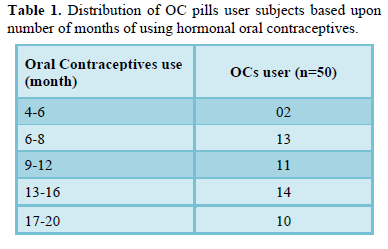

Serum CRP determined by latex agglutination method; therefore, CRP level is quantifiable not statistical measurable. Among fifty OCs user women, CRP test of twenty-nine were CRP negative and twenty-one showed CRP positive (undiluted) result with concentration of 6 mg/L. All non-OCs user women were CRP-negative (Table 3). The liver synthesized enzymes were assessed in OCs user and non-user group, it was observed that level of serum ALT was in normal ranges (10 to 46 u/l), but was raised significantly in OCs users with mean values 30.76±2.89 as compare to mean values 24.11±1.43 of OCs non-user control group with p
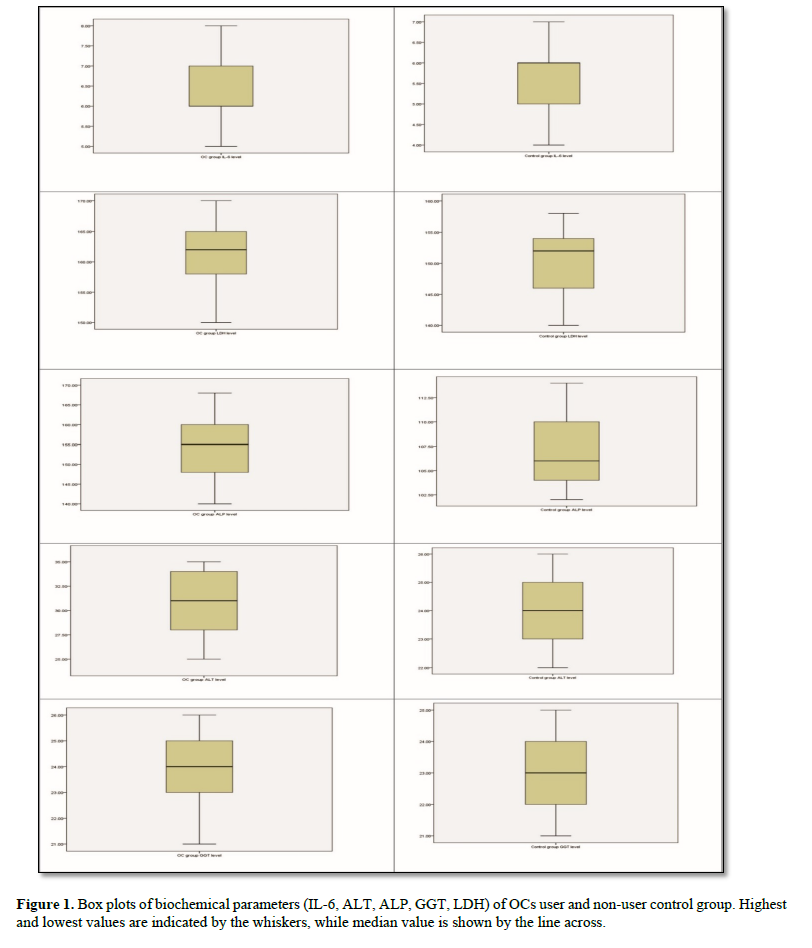
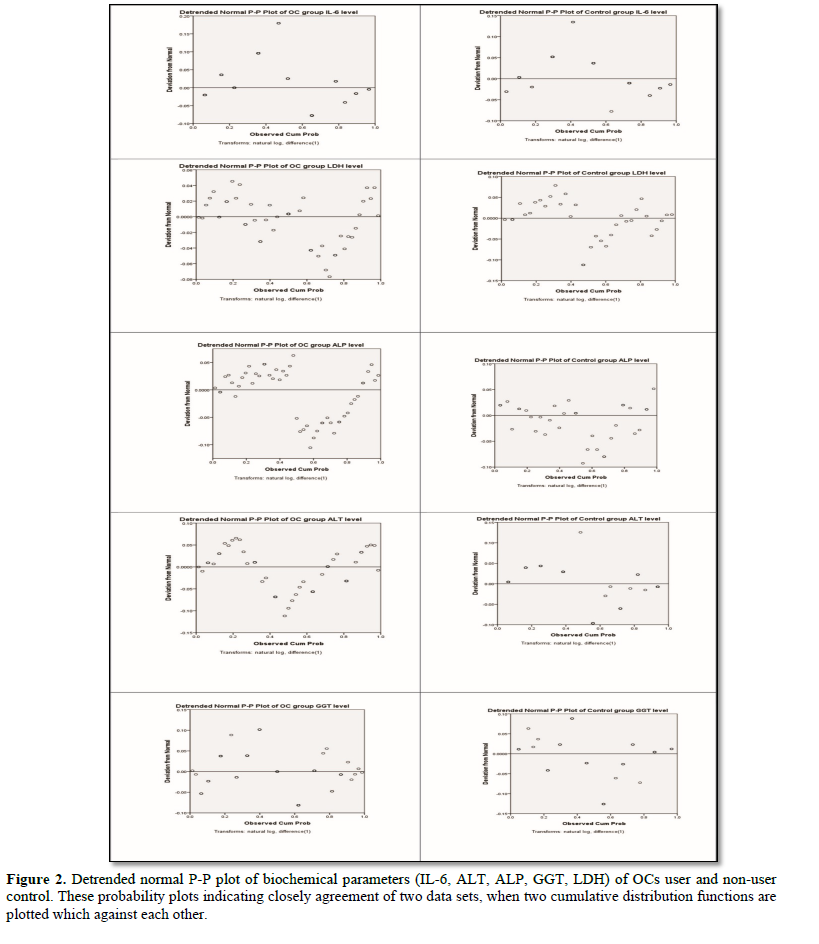
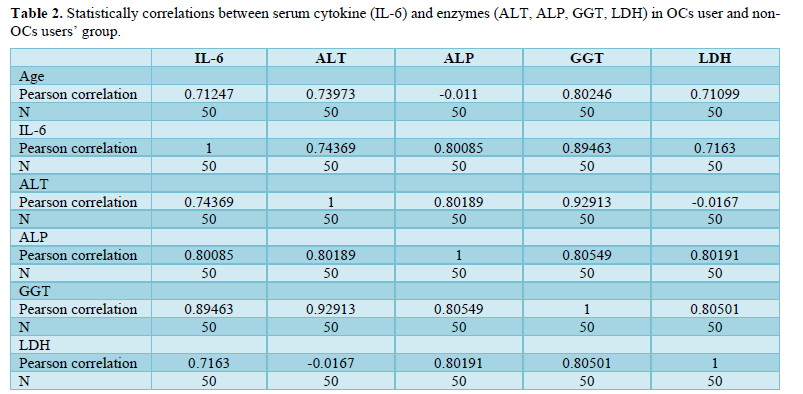



23.23±1.51 of serum GGT in control group with p=0.103 (Table 4, Figures 1 and 2). Statistical analysis confirmed significant difference in the average behaviors of serum ALT and ALP in OCs user and control group. Pearson correlation analysis showed positive correlation 0.802 between OCs women age and GGT, while highly negative correlation -0.016 was observed between serum ALT and LDH levels of OCs user group. A moderate nature of relationship showed by the correlation co-efficient showed. GGT and ALT had a direct relationship inverse relationship; while weak relationship between IL-6 and ALT was observed with 0.743. (Table 2).
OCs group women also showed significant difference in mean values 166.26±25.21 of serum LDH levels in comparison to control group LDH mean values 150. 08±28.19 with p<0.0001, however, serum LDH values of both, OCs users and non-users were in reference ranges (100 to 190 u/l) (Table 4, Figures 1 and 2) Furthermore, statistical analysis also indicated that LDH had positive correlation with serum ALP and GGT levels with 0.801 and 0.805 respectively (Table 2).
DISCUSSION
Globally, the most commonly use form of hormonal contraception is the oral contraceptive pill Previous studies highlighted that estrogen progesterone combined hormonal contraception are effective in providing protection against pregnancy and are using by most of the women. The excessive hormonal contraception use is associated with various medical conditions especially cardiovascular complications. Previously developed OC pills contained increase estrogens
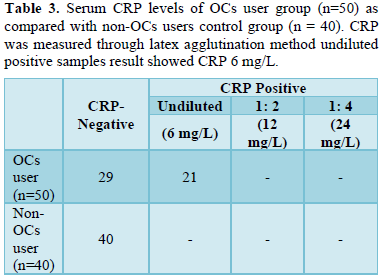
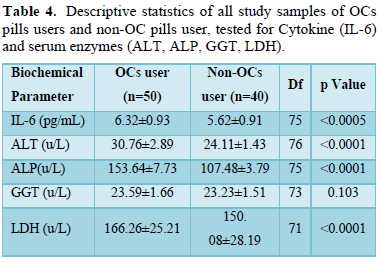


and progestins concentrations that was causing intolerable adverse effect like headache, nausea, vomiting, irregular bleeding, obesity and venous thromboembolism. Enovid 10, was the first marketed OC pill which was contained progestin norethynodrel (9.85mg) and estrogen mestranol (150μg). Today, reduce estrogens and progestins containing pills are using to control the posology. The OCs pills which are using now a days contain low hormone doses, modern progestins (0.1 to 3.0mg) and estrogens (20 to 50μg) [17]. Currently, various considerable modifications in OCs regimes have been made in order to reduce dosage frequency, menstruations duration and other related adverse effects for instance, dysmenorrhea and intermenstrual migraine. In clinical setting, the extended-release OCs pills are more appreciating because they are more effective in preventing pregnancies as compare to traditional OCs regimes and also provide improved outcomes in terms of menstrual symptoms [18]. Literature review reported many pathological conditions are associated with the use of OCs pills. Inflammatory processes are involved in OCs induced pathological conditions and many plasma inflammatory markers have been used as potential tools for early prediction of the OCs induced diseases or vascular events. Among these markers, systemic inflammatory biomarkers produced by liver such as CRP, cytokines (Tumor necrosis factor-alpha, interleukin-6) and monocyte chemotactic protein-1 [19].
With this background information, we intended to investigate serum pro-inflammatory cytokine (IL-6) and liver enzymes as biomarkers related to bodily inflammation process and hepato cellular damage. These biomarkers were evaluated in serum samples of OCs user (n=50) and non-OCs user (n-40) group through ELISA and photometry-based assay. The study results revealed significant elevation in serum IL-6 levels in OCs user group as compare to non-OCs user group with p
In present study, we found that 42% OCs users showed serum CRP levels (6 mg/L), and 58% OCs user women and control group showed negative CRP test. (Table 1). The elevation in serum CRP level in OCs group was also in agreement with the findings observed by Piltonen [21] they studied combined hormonal contraceptives effects in women [22]. Karim [22] conducted a prospective study on postmenopausal women and found significantly increase in four inflammatory markers (CRP, IL-6, serum amyloid A & sICAM-1) in 122 women with history of cardiovascular events in comparison to control group comprise of 224 women with no history of cardiovascular events and concluded these biomarkers as potentially predictors of future cardiovascular events [23]. Rooijen [20] explained that plasma CRP is hepatic response to inflammation and there consider as inflammatory marker. They also showed significant high level of CRP among OCs users as compare to control [21]. Divani [13] evaluated hormonal contraceptive effects among female subjects who were using combined OCs and combined vaginal contraceptive and observed elevated CRP level in both oral and vaginal contraceptive users and CRP levels were positively correlated with IL-6 and sTNF-RI [14]. High plasma CRP levels have been confirmed in previously performed studies on OCs user women as compare to control and they concluded that elevated plasma CRP is related with moderate to high risk of future cardiovascular events [8]. In another study, metabolic and cardiovascular parameters were evaluated in OCs user women and those women who were using levonorgestrel-releasing intrauterine device and study results revealed significantly high systolic and diastolic blood pressure and elevated inflammatory indices (C-reactive protein). They concluded that OCs usage linked with adverse findings in cardiovascular, metabolic, and inflammatory parameters that can serve as predictor of cardiovascular events and metabolic disorders [24].
Earlier studies have documented the use of OCs pills linked with the development of benign hepatic adenoma. The mechanism of development of tumor by progestins is still not clear, however, it is proposed that procarcinogenes are converted into carcinogens by the progestins induced homooxygenases [25]. In this study, serum enzymatic (ALT, ALP, GGT, LDH) profile was assessed among OCs users and non-users’ group. In the present work, liver health status of OCs users was assessed through the estimation of serum ALT levels, and found significantly elevation in comparison to non-OCs user group with p<0.0001, though, serum ALT values were in normal ranges. While in OCs user group, serum ALP was not only significantly raised as compare to control group with p<0.0001, but was also high from reference range. But no statistically significant difference was observed in serum GGT level between OC user and non-user group with p=0.103. Serum LDH levels of OC user group were in normal ranges but in comparison to control group, LDH level was significantly high with p(Table 1, Figure 1). In OC user group, average behaviors of serum ALT, ALP and LDH was significantly change, a positive correlation was observed between LDH and ALP and highly negative correlation between serum ALT and LDH levels of OCs user group. (Table 2) Similarly, increase in serum LDH was found among OCs users by Naz [25] they reported increased use of OCs pills can alter normal lipids and serum enzymes profile among OCs users [26]. Oral contraceptives pills induced hepatotoxicity was also studied in female rabbits by Ekhato [26] they found total bilirubin, AST and ALT levels were significantly increased in OCs given female rabbits and suggested that regardless of OCs pills dosages, hepatotoxicity is associated with them [27]. Also, Walch [27] observed significantly increase (p<0.05) in liver enzymes (ALT, AST and ALP) activities in patients that were receiving DMPA. This increase in enzyme activity was attributed to altered liver enzymes metabolism and/or integrity of liver membrane may be compromised.
CONCLUSION
In conclusion, we observed even though estrogens produce in women body, but its daily intake in the form of OCs pills may increase estrogen concentration in the body. The prolong OCs pills use elevates systemic inflammatory marker and liver enzymes in blood that in clinical terms can be associated with acute/chronic inflammation or low degree of severity disease. This increase in biochemical parameters may be due to altered hepatic metabolism or due to inflammatory response. These biochemical parameters must be examining continuously as estrogens has mitogenic activity.
RECOMMENDATIONS
We recommend that OCs user women must undergo periodic liver tests for early detection and diagnosis of OCs induce hepatotoxicity. Furthermore, intake of liver tonic can maintain liver membrane integrity.
ETHICAL APPROVAL
All procedures of present work involving human participants were performed according to the ethical standards of the institutional research committee. The study protocol was approved by the institutional ethical review board and to hide the identity of subjects, all samples were labeled with specific codes.
DISCLAIMER
None.
CONFLICT OF INTEREST
None.
SOURCE OF FUNDING
Author beard all the expenses by himself.
ACKNOWLEDGEMENT
We are grateful to all the volunteer OCs user women and healthy non-OC user women for participation in the present study.
- Petitti DB (2003) Combination estrogen-progestin oral contraceptives. N Engl J Med 349: 1443-1450.
- Shufelt CL, Merz CNB (2009) Contraceptive hormone use and cardiovascular disease. J Am Coll Cardiol 53: 221-231.
- Linton A, Golobof A, Shulman LP (2016) Contraception for the perimenopausal woman. Climacteric 19: 526-534.
- Kluft C, Leuven JAG, Helmerhorst FM, Krans HM (2002) Pro-inflammatory effects of estrogens during use of oral contraceptives and hormone replacement treatment. Vascul Pharmacol 39: 149-154.
- Wang M, Jin W, Guo AM, Stubbe J (2013) Cardiovascular inflammation. Mediators Inflamm 2013: 123513.
- Teede HJ, Meyer C, Hutchison SK, Zoungas S, McGrath BP, et al., (2010) Endothelial function and insulin resistance in polycystic ovary syndrome: The effects of medical therapy. Fertil Steril 93: 184-191.
- Harmanci A, Cinar N, Bayraktar M, Yildiz BO (2013) Oral contraceptive plus antiandrogen therapy and cardiometabolic risk in polycystic ovary syndrome. Clin Endocrinol (Oxf) 78: 120-125.
- Buchbinder S, Kratzsch J, Fiedler GM, Yar V, Brügel M, et al., (2008) Body weight and oral contraceptives are the most important modulators of serum CRP levels. Scand J Clin Lab Invest 68: 140-144.
- Lupo M, Dains JE, Madsen LT (2015) Hormone replacement therapy: An increased risk of recurrence and mortality for breast cancer patients? J Adv Pract Oncol 6: 322-330.
- Lovett JL, Chima MA, Wexler JK, Arslanian KJ, Friedman AB, et al., (2017) Oral contraceptives cause evolutionarily novel increases in hormone exposure: A risk factor for breast cancer. Evol Med Public Health 2017: 97-108.
- Liu SH, Lazo M, Koteish A, Kao WL, Shih MH, et al., (2013) Oral contraceptive pill use is associated with reduced odds of nonalcoholic fatty liver disease in menstruating women: Results from NHANES III. J Gastroenterol 48: 1151-1159.
- Pizzino G, Irrera N, Cucinotta M, Pallio G, Mannino F, et al., (2017) Oxidative stress: Harms and benefits for human health. Oxid Med Cell Longev 2017: 8416763.
- Divani AA, Luo X, Datta YH, Flaherty JD, Mortari AP (2015) Effect of oral and vaginal hormonal contraceptives on inflammatory blood biomarkers. Mediators Inflamm 2015: 379501.
- Charan J, Kantharia ND (2013) How to calculate sample size in animal studies? J Pharmacol Pharmacother 4: 303-306.
- Zhang P, Bao Y, Draz MS, Lu H, Liu C, et al., (2015) Rapid and quantitative detection of C-reactive protein based on quantum dots and immunofiltration assay. Int J Nanomedicine 10: 6161-6173.
- Grandi G, Cagnacci A, Volpe A (2014) Pharmacokinetic evaluation of desogestrel as a female contraceptive. Expert Opin Drug Metab Toxicol 10: 1-10.
- Edelman A, Micks E, Gallo MF, Jensen JT, Grimes DA (2014) Continuous or extended cycle vs. cyclic use of combined hormonal contraceptives for contraception. Cochrane Database Syst Rev 2014(7): CD004695.
- Ballantyne CM, Nambi V (2005) Markers of inflammation and their clinical significance. Atheroscler Suppl 6: 21-29.
- Kassebaum NJ, Arora M, Barber RM, Bhutta ZA, Brown J, et al., (2016) Global, regional, and national disability-adjusted life-years (DALYs) for 315 diseases and injuries and healthy life expectancy (HALE), 1990-2015: A systematic analysis for the Global Burden of Disease Study 2015. Lancet 388: 1603-1658.
- van Rooijen M, Hansson LO, Frostegård J, Silveira A, Hamsten A, et al., (2006) Treatment with combined oral contraceptives induces a rise in serum C‐reactive protein in the absence of a general inflammatory response. J Thromb Haemost 4: 77-82.
- Piltonen T, Puurunen J, Hedberg P, Ruokonen A, Mutt SJ, et al., (2012) Oral, transdermal and vaginal combined contraceptives induce an increase in markers of chronic inflammation and impair insulin sensitivity in young healthy normal-weight women: a randomized study. Hum Reprod 27: 3046-3056.
- Karim R, Stanczyk FZ, Hodis HN, Cushman M, Lobo RA, et al. (2010) Associations between markers of inflammation and physiological and pharmacological levels of circulating sex hormones in postmenopausal women. Menopause 17(4): 785-790.
- Papunen LM, Martikainen H, McCarthy MI, Franks S, Sovio U, et al. (2008) Comparison of metabolic and inflammatory outcomes in women who used oral contraceptives and the levonorgestrel-releasing intrauterine device in a general population. Am J Obstet Gynecol 199(5): 529.e1-529.e10.
- Sage PB, Sempoux C, Possenti L, Frulio N, Laumonier H, et al. (2013) Pathological diagnosis of hepatocellular cellular adenoma according to the clinical context. Int J Hepatol 2013: 253261.
- Naz F, Jyoti S, Akhtar N, Siddique YH (2016) Effect of Oral Contraceptive Pills on the Blood Serum Enzymes and DNA Damage in Lymphocytes Among Users. Indian J Clin Biochem 31: 294-301.
- Ekhator CN, Osifo UC, Akpamu U (2014) Effect of oral contraceptive pills (containing low doses of synthetic hormones) on liver function in adult female rabbits. Asian J Biotechnol 6(1): 15-20.
- Walch K, Unfried G, Huber J, Kurz C, van Trotsenburg M, et al. (2009) Implanon® versus medroxyprogesterone acetate: Effects on pain scores in patients with symptomatic endometriosis-a pilot study. Contraception 79: 29-34.
QUICK LINKS
- SUBMIT MANUSCRIPT
- RECOMMEND THE JOURNAL
-
SUBSCRIBE FOR ALERTS
RELATED JOURNALS
- International Journal of Diabetes (ISSN: 2644-3031)
- Journal of Infectious Diseases and Research (ISSN: 2688-6537)
- BioMed Research Journal (ISSN:2578-8892)
- International Journal of Radiography Imaging & Radiation Therapy (ISSN:2642-0392)
- Journal of Psychiatry and Psychology Research (ISSN:2640-6136)
- Chemotherapy Research Journal (ISSN:2642-0236)
- International Journal of Internal Medicine and Geriatrics (ISSN: 2689-7687)

